Blur Studio and Chaos enable the live-action director to bring his signature low-light look to the CG medium for a Love, Death + Robots episode.
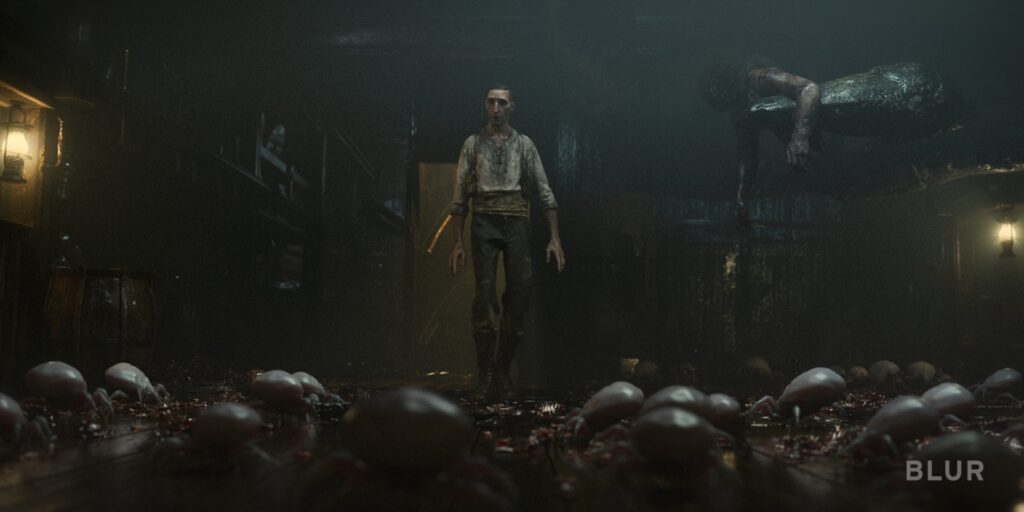
“I love any story where the entire cast dies. We’re going to get to feed them all to a giant crab.” With a quote like that from the filmmaker, you know this is not a Disney film.
Award-winning director David Fincher is known for films exploring the darker side of human morality: Fight Club, Mank, The Panic Room, Gone Girl, and others. He is also known for his dark color palettes, monochrome colorings, and low-key lighting in his live-action films. Staying true to his signature aesthetic and dark characters (in more ways than one), he applied a similar style within an all-CG world for his first fully-animated production, “Bad Travelling,” a Love, Death + Robots (Netflix) anthology episode.
The animated short film also marks the first time Fincher has directly contributed to the Netflix anthology he executive produces alongside Tim Miller (Deadpool, Terminator: Dark Fate). The adult streaming series comprises stand-alone animated episodes from various studios, with each containing a unique storyline, animation style, and genre (comedy, horror, science-fiction, or fantasy).
The CG thriller tells the story of a dishonest crew sailing alien seas, and a monster that strikes a murderous deal with the ship’s captain. The film is 19 minutes in length, and Fincher wanted to start right in the middle of the action, so it needed to make sense visually and from a character standpoint, what this world is and how it is working.
David Fincher read the original short story that inspired ‘Bad Travelling’ 15 years ago, and the idea never really left his mind. “I thought it would be fun. I think people would relate to the idea of having a truly miserable job, being tossed at sea and then fed to crustaceans,” Fincher says.
No one can argue with that. But, while creating this animated short was fun, it was hardly smooth sailing while exploring what were unchartered waters for Fincher.
To create the nautical world of “Bad Travelling,” Fincher worked with the team at Miller’s animation and VFX firm, Blur Studio. “It’s really amazing just to see how inspired and just fanatical they are, David Fincher and Tim Miller, about the show and about the animation,” says Jennifer Yuh Nelson, supervising director, Love, Death + Robots. “They love this process.”
Fincher admits that he is much more comfortable in a live-action environment but points out that you are using basically the same kind of tools—except you can do much more. “You can change people’s facial reactions, which helps,” he says, because you can go, ‘that thing he does here, that’s really great. Let’s pull it up about 6 seconds.’”
For those working with Fincher on this film, it was like having a little master class in whatever subject they’re in, according to Nelson. “To hear him talk about camera and to talk about his shot philosophy is really like going to film school. You learn so much—everybody in the whole process in the studio as they’re hearing him give notes on camera, on lighting, on just every single detail. So, everybody got to be better.”
To help Fincher embrace the darkness in his latest work, the studio used the lighting tools in Chaos’s V-Ray for 3ds Max.
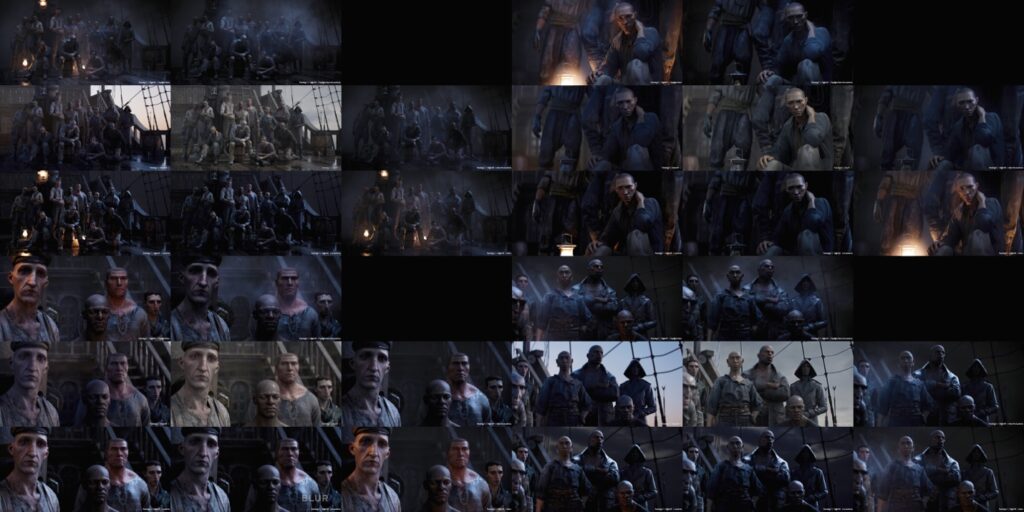
“Even though ‘Bad Travelling’ was his first animation project, we quickly understood that Fincher was naturally curious, always looking to find new ways to explore his craft. However, there were definitely new things for him to learn about working with animation as a medium,” says Jean-Baptiste Cambier, co-CG supervisor at Blur Studio. “Unlike live action, animation does not often leave much room for on-set happy accidents or instinctive decisions—everything is thought about, planned, and calculated.”
To counteract this, the Blur team leveraged V-Ray’s Light Selects and Physical Camera Exposure controls to bridge the gap between live action and CG. By rendering sequences this way at an early stage, they were able to achieve more intuitive results with shots that didn’t look overworked. The team also built a proprietary tool for Foundry’s Nuke called Light Rig, which allowed them to treat V-Ray’s Light Selects as a cinematographer would on set. The exposure of each individual light could be controlled interactively, without re-rendering, ensuring that the environment, characters, and fluid sims could be lit on the fly, in real time.
Lighting like Fincher
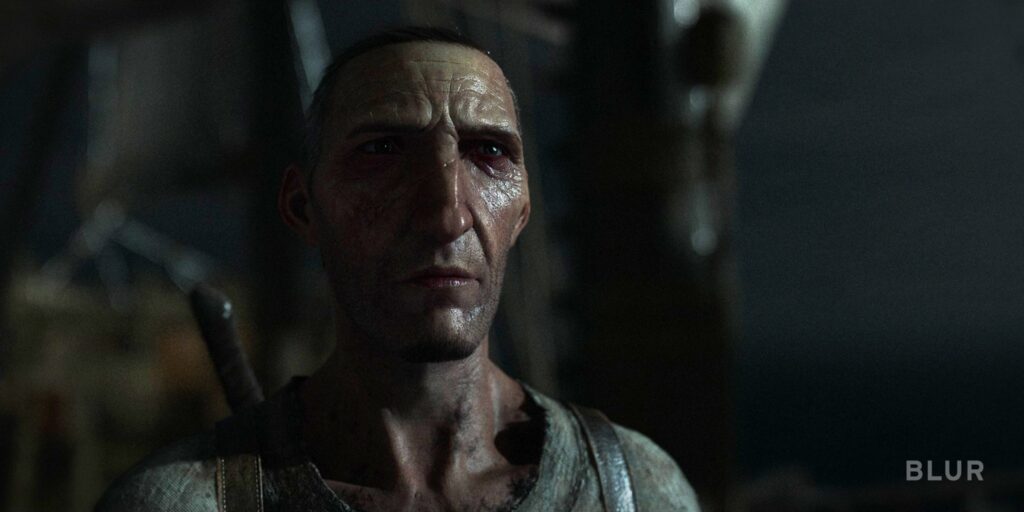
Work on lighting began early in Blur’s lookdev process, which involved refining the aesthetic of each sequence before assets were made. “Fincher is keenly aware of the practicality of different textures, surfaces, and materials, and the physics of how they react to light in the real world,” says Nitant Ashok Karnik, compositing supervisor at Blur. “His eye for color is insanely precise. For example, when we were establishing lighting for the ship’s cargo hold, Fincher specified that he only wanted oil lanterns and moonlight—specifically 1,800K and 4,000K, respectively. And of course, they were all spot-on in look and feel.”
As well as lighting and color, Fincher was also very intentional about how the audience should feel during key scenes. The sunset in the story, for instance, had to look ugly, with greenish hues reminiscent of his movie Se7en. Meanwhile, the ship where the film takes place had to feel disgusting, with a dark cargo hold below deck that would feel hellish and dank—exactly the kind of place the story’s crustacean monster would be found.
“We worked hard to make these characters feel like they were in a horrible, wretched place, and to make the audience feel as uncomfortable as the characters looked,” says Karnik. “We also played with lighting on the characters. For the antihero, Torrin, our art director had the idea of using a 50/50 lighting style, where only half his face was lit. Conceptually, we thought this lighting mirrored how morally gray his behavior was. You can see this transition from the beginning of the short, where the light wraps across Torrin’s face, to the end when he’s murdered his entire crew and his face is half-lit.”
Swaying the sea
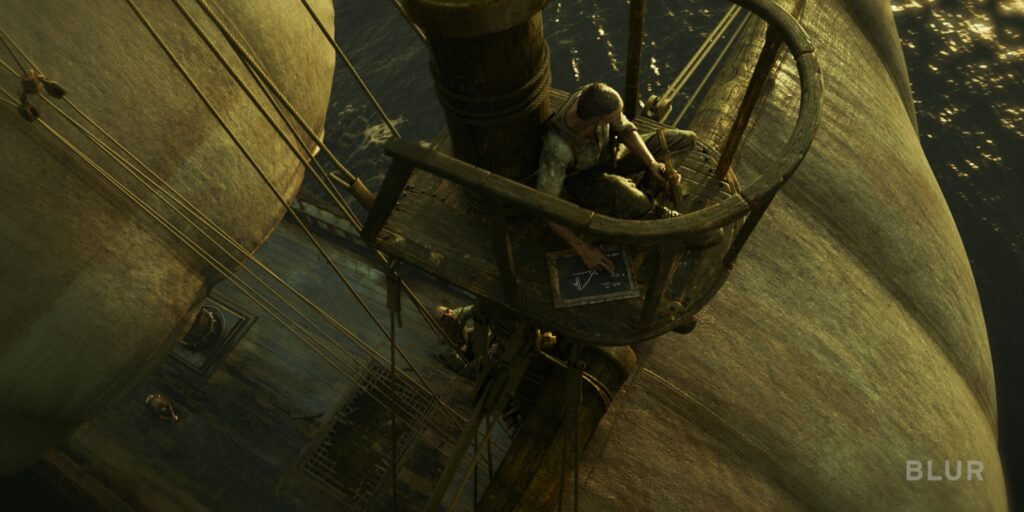
Being able to create a realistic, horrifying seascape was also key to ensuring the final animation felt immersive. To do this, the Blur Studio team used V-Ray’s infinite VRayPlane to define the horizon lines throughout each sequence.
“Everything in ‘Bad Travelling’ happens on a boat at sea,” says Cambier. “This represents a relatively contained space, so we knew that our representation of parallax and scale was key to making the final render look realistic.”
Once the horizon lines were defined, the team had to create the illusion of constant swaying from the ocean’s waves, which had to be checked in animation previews. There were two ways to do this: sway the whole boat and all the characters on it, as well as the cloth and hair; or simply move everything around the boat to give the illusion of swaying.
“The choice was quickly made to sway all that is around the boat, as it would have been a nightmare to animate everything happening on the deck,” says Cambier. “Using the VRayPlane was essential for this, too. It allowed us to do some simple coding to include and snap that infinite ocean in all our renders, from animation, to lighting, all the way to the final comp.”
Despite having just six months to deliver 386 shots, the Blur team was able to complete “Bad Travelling” on schedule by optimizing their workflow. “Chaos have been our partners in crime for a very long time. Even David Fincher’s relationship with V-Ray goes way back: His video for ‘Only’ by Nine Inch Nails (created with Digital Domain) was the first time V-Ray’s photorealistic ray tracing was used in a commercial project,” Cambier notes.
Miller, with an extensive background as a CG/VFX supervisor, embraces animation, and having “arguably one of the greatest living filmmakers of all time says, ‘I’m going to spend my time making an animated film,’ that should tell you that the medium has arrived.”
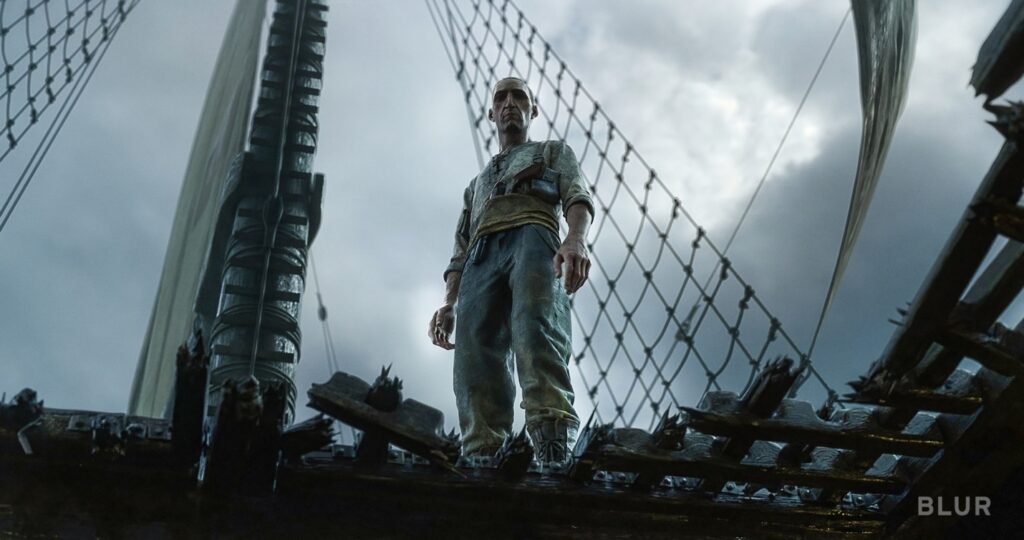
“Bad Travelling” was the second episode of Love, Death + Robots Season 3. The series is said to be a re-imagining of Fincher and Miller’s 1981 animated sci-fi film Heavy Metal, which was adapted as a series rather than a feature-length film. The anthology, which features dark comedy along with terrifying creatures, received Emmys for Outstanding Short Form Animated Program in 2019 and 2021, and has been nominated for the upcoming 2022 race. It appears that the formula of the strange but well animated works.
Season 1 comprised 18 episodes; Season 2, eight episodes; and Season 3, nine episodes. Fincher promises that the next volume has “every chance of being even weirder than anything you thought it was going to be.”
He adds: “My hope is that we never get to a point where we have succinctly defined what LDR is. That would be boring.”





